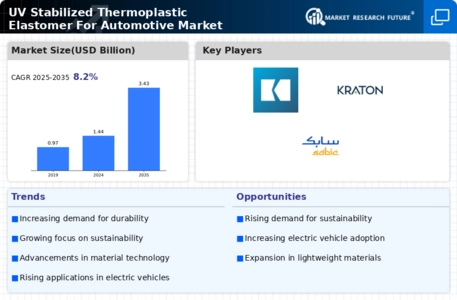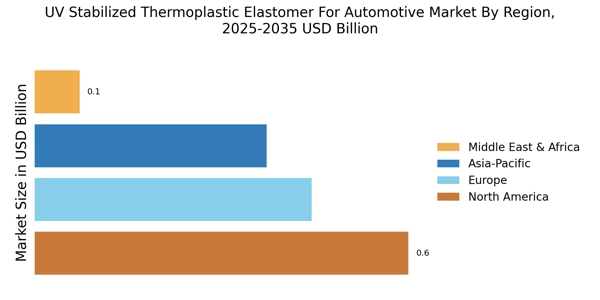The UV Stabilized Thermoplastic Elastomer for Automotive Market is currently characterized by a dynamic competitive landscape, driven by increasing demand for lightweight, durable materials that can withstand harsh environmental conditions. Key players such as Kraton Corporation (US), BASF SE (DE), and Kuraray Co Ltd (JP) are strategically positioned to leverage their technological expertise and extensive product portfolios. Kraton Corporation (US) focuses on innovation in polymer chemistry, aiming to enhance the performance characteristics of their elastomers. Meanwhile, BASF SE (DE) emphasizes sustainability in its operations, integrating eco-friendly practices into its manufacturing processes. Kuraray Co Ltd (JP) is actively pursuing regional expansion, particularly in Asia, to capitalize on the growing automotive sector in that region. Collectively, these strategies contribute to a competitive environment that is increasingly focused on innovation and sustainability.
In terms of business tactics, companies are localizing manufacturing to reduce lead times and optimize supply chains. The market structure appears moderately fragmented, with several key players holding significant market shares while also facing competition from smaller, specialized firms. This fragmentation allows for a diverse range of products and innovations, although the influence of major players remains substantial in shaping market trends and consumer preferences.
In August 2025, Kraton Corporation (US) announced the launch of a new line of UV-stabilized thermoplastic elastomers specifically designed for automotive applications. This strategic move is likely to enhance their market position by addressing the growing demand for materials that offer superior UV resistance and durability, thereby appealing to automotive manufacturers seeking to improve vehicle longevity and performance.
In September 2025, BASF SE (DE) unveiled a partnership with a leading automotive manufacturer to develop a new range of sustainable thermoplastic elastomers. This collaboration underscores BASF's commitment to sustainability and innovation, potentially setting a new standard in the industry for environmentally friendly materials that do not compromise on performance.
In July 2025, Kuraray Co Ltd (JP) expanded its production capacity for thermoplastic elastomers in Southeast Asia, responding to the increasing demand from the automotive sector in that region. This expansion not only strengthens Kuraray's market presence but also positions the company to better serve its customers with localized production, thereby enhancing supply chain efficiency.
As of October 2025, the competitive trends in the UV Stabilized Thermoplastic Elastomer for Automotive Market are increasingly influenced by digitalization, sustainability, and the integration of advanced technologies such as AI. Strategic alliances are becoming more prevalent, as companies recognize the need to collaborate in order to innovate and meet evolving consumer demands. Looking ahead, competitive differentiation is likely to shift from traditional price-based competition to a focus on innovation, technological advancements, and the reliability of supply chains, as companies strive to establish themselves as leaders in a rapidly evolving market.


















Leave a Comment